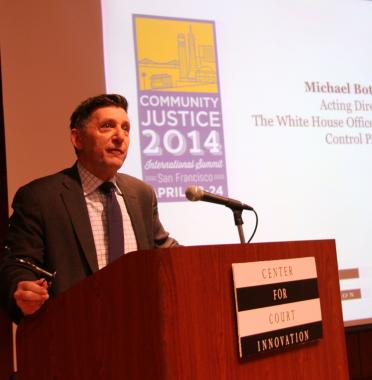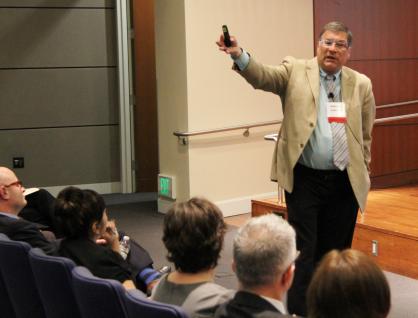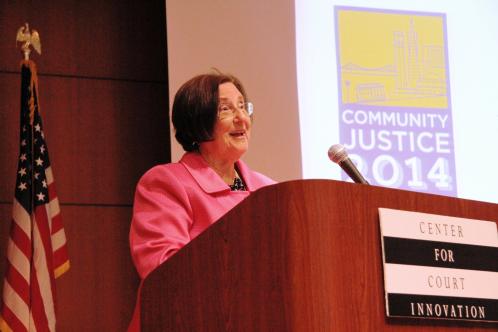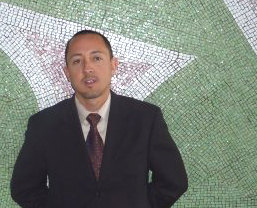Courts need to assess offenders for traumatic exposures so they can match them to effective services and improve
treatment outcomes, says Kathleen West, an expert on trauma-informed care and lecturer at the University of California.
In this New Thinking podcast, West discusses what we know about the impact of trauma on litigants and the justice
system. (April 2014)
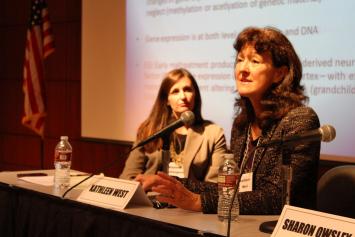 Kathleen West participates in a panel on linking defendants
Kathleen West participates in a panel on linking defendants
to services at Community Justice 2014.
KATHLEEN WEST: Trauma exposure is not equally distributed across our population, so some communities have
a lot, a lot of risk, just certain zip codes have, you know, great risk for being exposed to trauma.
ROBERT
V. WOLF: Hi, I’m Rob Wolf, director of communications at the Center for Court Innovation, and I am at the Community
Justice 2014 International Summit in sf. I’m speaking with one of the presenters right now, Kathleen West, who
is a researcher. She lectures at UCLA and the University of Southern California, and today she was here speaking
about linking defendants to services, with an emphasis on trauma informed care, and the role trauma has played in
the lives of many people who find themselves in the criminal justice system, and how the justice system can start
considering the effects of trauma when working with these clients and offenders. Thank you very much for taking the
time to speak with me.
WEST: Thanks.
WOLF: So let’s talk a little bit
about trauma-informed care. What is it, exactly?
WEST: Well, basically it means to consider the
traumatic exposures that your clients have had, or your defendants have had, and that you need to be assessing for
trauma exposures, making sure that you are aware of what the background traumatic exposure might be, and that your
system of care is not traumatogenic, that you are not exacerbating the problems, that you’re also not putting
clients in programs where they’re not likely to succeed. You don’t want to set them up to fail if the structure
or ambiance of the program, or the jail or correctional facility is going to induce more trauma, because we know
that folks that are in traumatized states that may have a PTSD diagnosis—
WOLF: Post traumatic—
WEST: Post traumatic stress disorder, or if you really actually have a full blown diagnosis with a disorder
there where you’ve moved into a state of pathology in managing your traumatic stress, then you may not be able
to receive treatment in a way that it’s designed, if you’re not really considering the traumatic effect.
Also we’ve found that a lot of our courts, while not intending to do harm, can do harm both to the practitioners
in the court systems by vicarious trauma, where a lot of our practitioners are clerks or attorneys, are exposed to
a lot of trauma and then we’re traumatogenic in sharing that across our system so that we’re actually—it’s
not just our clients that are suffering, perhaps, but some secondary traumatization can happen as well.
WOLF: So when we speak of the effect on clients, one thing I’m hearing you say is that if you don’t
assess or evaluate the level of trauma they may have experienced in their life, you might not be able to match them
effectively to treatment.
WEST: That’s right, absolutely. So it’s really matching the
treatment issues. So we had a lot of discussions here around risk assessment and that is one element of assessment
that you certainly, obviously, have to do, but traumatic exposure assessment has been rarely done. I think the reason
why this has become a bigger public health awareness issue is really with the average childhood experiences study,
which is a massive longitudinal study, it’s called the ASA study, and it was a very big, ongoing still, longitudinal
study done by the Kaiser Health System. And what they identified was that exposure to what they called adverse childhood
experiences—and that’s an assessment tool that looked at 10 different kinds of exposures that included things
like having a parent in jail, or being abused physically oneself—ended up with a lot of negative health consequences
later on as an adult, including, some of this included traumatic exposures. And now we’re aware that we really
ought to be assessing for those factors as well, that are not criminogenic factors, that we don’t necessarily
think of as risk factors in the same way, but that actually can be a, can make a big difference whether people can
succeed or cannot comply with a program. So, making the distinction between inability to comply and non-compliance
is a really important distinction we’d like to make here, I think. They might look the same, but I think our
ethical obligation to respond to them is different. If somebody is unable to comply because of various exposures
or inability to do things that they have, that’s one thing. But if they are none compliant, that’s something
else. So we need to tease out that difference and try to match our programming appropriately.
WOLF:
And is there the capacity to do that? Do we have the tools to differentiate between those who are unable to comply
and those who are, I guess, who aren’t complying for some sort of willfulness?
WEST: I think
there are the tools available and we’re getting to that place. I’m not gonna be able to name a specific
tool at the moment because I think it really does vary, actually, on the population you’re looking at. But yes,
we are getting to the place where there are those resources available. The Substance Abuse and Mental Health Services
Administration, SAMSA, has an entire website devoted to trauma-informed care, there’s a national clearinghouse,
national center on trauma-informed practices, trauma-informed care. The National Center for Child Traumatic Stress,
NCTSN, has a lot of resources available. Where understanding and evaluating trauma, and then matching what kind of
programs might be available is very important. Also medication management should be influenced by a trauma exposure
assessment as well.
WOLF: And before we started, you referred to the issue of including trauma-informed
care and just the epidemic nature of trauma on certain populations as a public health problem. And I wonder if you
could elaborate on that because I think a lot of people are also interested in the nexus between the justice system
and public health.
WEST: I’m delighted to hear that. I mean I know that that’s really
why I’m here, is the community courts, community justice movement. I do see this as a public health issue. I think
a lot of public health practitioners are increasingly aware that all of our highest risk patients, clients, are also
in the criminal justice system, often times, and when they are not in the criminal justice system, they are recycling
in and out, you know, on the streets, homelessness, domestic violence, problems with the ability to maintain jobs,
employment, certainly health issues, mental health issues, traumatic brain injury, and all sorts of things that are
challenges. So I think many of us certainly look at this as an intergenerational situation as well, that we really
want to get in there and provide early intervention and prevention, and a place where we can deal with this. In some
populations this is endemic. Trauma exposure is not equally distributed across our population, so some communities
have a lot, a lot of risk, just certain zip codes have, you know, great risk for being exposed to trauma, and what
we know for the most part is that the more you’re exposed, it doesn’t mean that you get better at managing
it, actually it’s additive and intensity, duration, and frequency all make a difference in whether or not you’re
able to be resilient. We really want to be looking at resiliency and how our courts can help people do that, so we’re
looking, trying strength-based, how we find pro-social kinds of things, how can we make sure that we’re not
asking people to do things that they can’t comply with and can’t do, just from even a physiological perspective,
and making sure that we give people the time to heal. We want to emphasize that even with a diagnosis of PTSD, this
is not a death now, but a long shot. There is treatment that’s effective and that people can manage and live
with that their whole lives. That’s really important to understand. But if it’s not taken into account
then you can’t treat it, and you may be misdiagnosing or missing something. And that’s just where I think
our courts, especially community courts, are so therapeutic in their approach, that this is just something they ought
not be missing in their assessment.
WOLF: When you talk about a public health approach, or a public
health problem, does it mean not only looking at trauma as a health problem, but applying some of the tools that
come from public health? I mean you refer to prevention and the criminal justice system is increasingly thinking
about prevention and thinking about recidivism. Does that have parallels in the public health system, like preventing
an illness, preventing a return of an illness?
WEST: Absolutely, and it also quite concretely
has a lot to do with good use of scarce resources, right? And the Affordable Care Act is really making people aware
that it makes so much more sense to do really good up front diagnosis, get in that preventative healthcare services,
and you won’t be seeing people in your emergency room, which is not a good place to deliver primary care. I
think there’s a real parallel there, where we ought to be doing better work in our community justice programming,
really identifying clearly at the beginning who we’ve got as high risk populations, screening out our low risk,
make sure we’re maintaining them well and addressing their needs right away, which can be really low cost. Early
intervention, not waiting until you have a frank pathology or a frank perpetrator, you know serious offender on your
hands. We ought to be investing more in our preschool programming, for example, or even in our courts we really need
to be looking at that whole family constellation, which is still our core of our socialization or social norms as
a family. So even when you’ve got a criminal court and we’re working with the defendant as a lone wolf,
they’re not a lone wolf. They’re somewhere embedded in a community with a family and somebody else. And
if we don’t, you know, pay attention to that community and try to support them, they’re gonna be a problem.
And I also think that as we’re looking at our higher risk folks, we need to provide that right dose of care,
identify what the problems are, and really intensively serve them so that we don’t see them, you know, coming
back in and out again of our system. It is an analogy to our healthcare system.
WOLF: Well I know
you have a plane to catch and I really appreciate your taking the time to talk to me.
WEST: Thank
you for your interest. I’m so glad you’re working on this, and I’m so glad to hear that you know, there might
be more opportunities for public health and our court systems to interact, so thank you.
WOLF:
I’ve been speaking Kathleen West, who is a researcher, a lecturer, at University of Southern California and
UCLA, and an expert on trauma-informed care. To find out more about the Center for Court Innovation, about this conference,
Community Justice 2014, or even about the nexus between public health and the justice system, you can visit our website
at www.courtinnovation.org. You can also listen to our New Thinking podcast on iTunes. I’m Rob Wolf, thanks
for listening.
Podcast: Play in new window | Download
